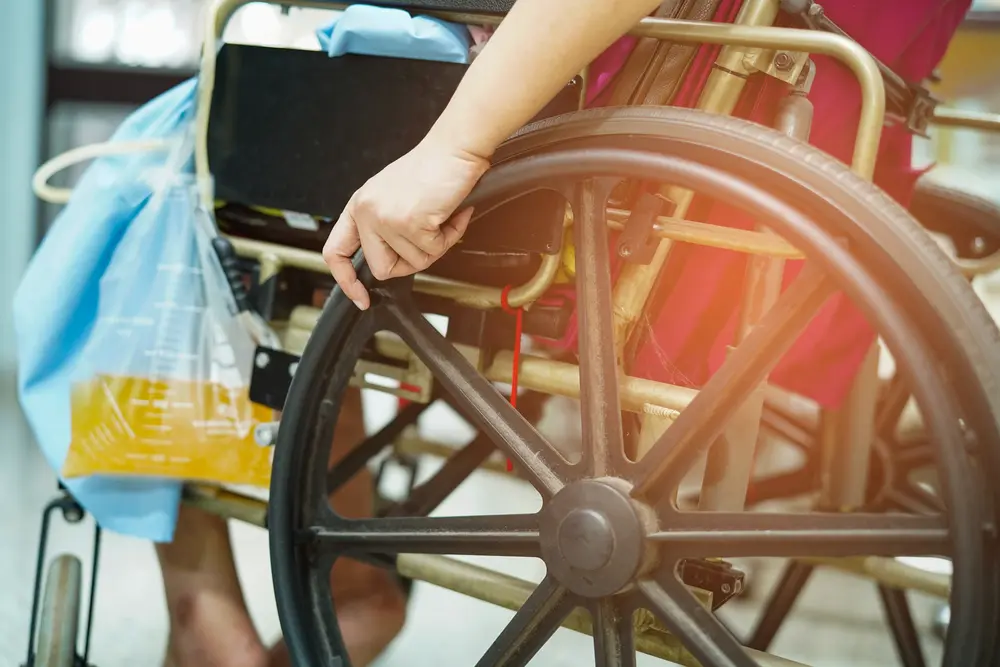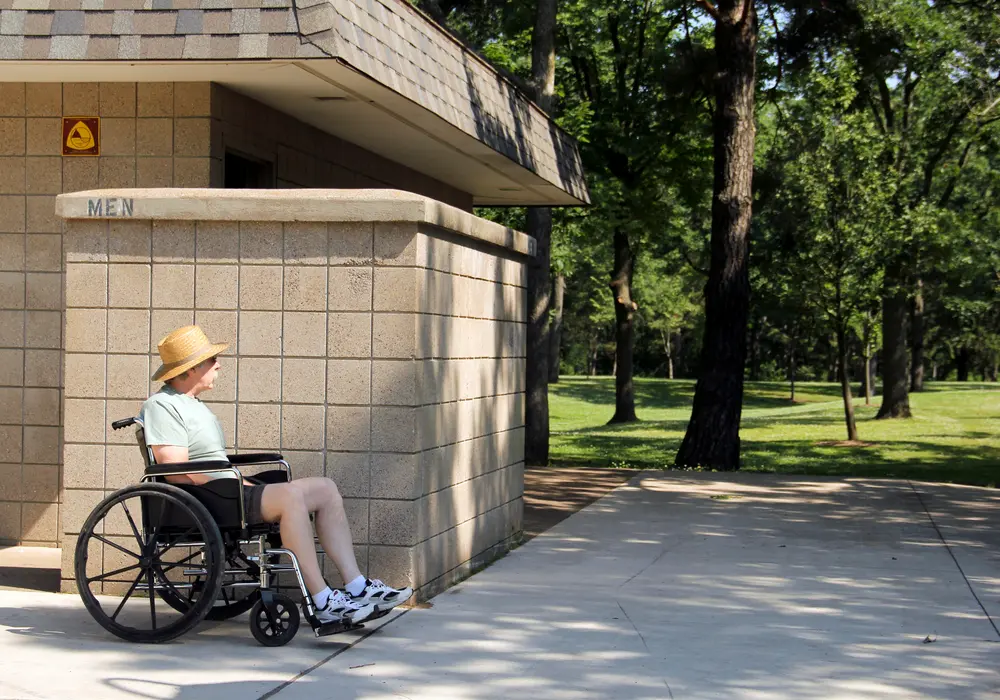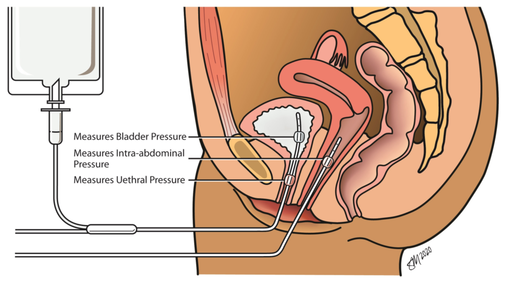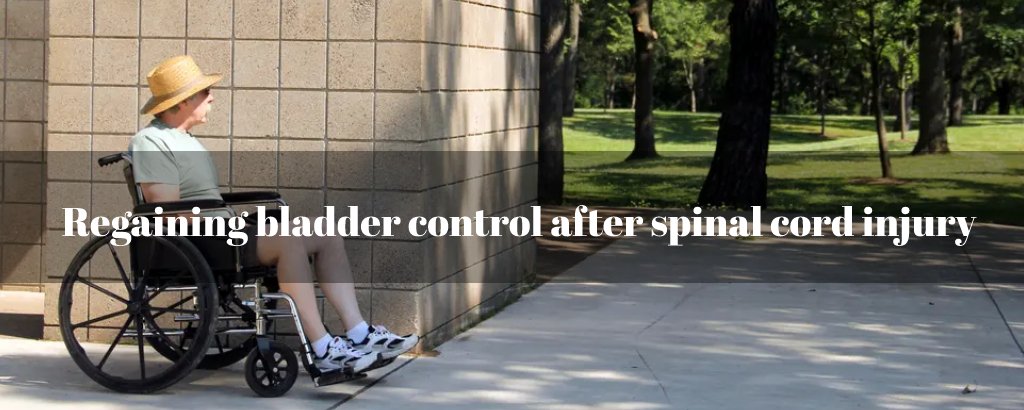Loss of normal control over urination is a common side effect of paralysis of the spinal cord of any severity.
According to the National Spinal Cord Injury Statistical Center, about 291,000 Americans live with a spinal cord injury, and many have bladder dysfunctions or lack control over their bladder.
This is because damage to the spinal cord makes it hard for signals to move back and forth, which makes it hard to empty the bladder.

Why does an SCI affect bladder control?
The nerves that regulate your bladder come from the sacral micturition region at the base of your spinal cord. These neurons inform the brain when the bladder requires emptying.
The nerves from spinal micturition also regulate the sphincter muscle at the bladder’s base, which acts as a valve, contracting to stop urine from leaking out of the bladder at inopportune times. To expel urine, the brain sends signals to the sphincter and bladder muscles to relax.
Since most spinal cord injuries are located above the sacrum, the connection between the brain and the spinal cord (sacral spine) is completely or partially disrupted. Only the areas above the lesion site retain pre-injury functionality, including bladder function after a spinal cord injury.
In this video, Dr. Susie Gronski, a physical therapist, explains the impact of a spinal cord injury on the bladder. She first explains the mechanism of how bladder dysfunction occurs, and in the end, she shares some options to treat bladder dysfunction.
Understanding the Different Types of Bladder Dysfunction
There is an acute reaction to damage to the spinal cord, referred to as a “spinal shock,” when the brain’s messages can’t reach some or all of the body below the damage, and the bladder doesn’t contract. Often, it only lasts a few days, but in the case of the bladder, it can go on for months.
But chronic loss occurs with a neurogenic bladder. This neurogenic bladder causes a person to lose the sensation of needing to urinate, which leads to an overflowing and leaking bladder. Simultaneously, people may have trouble entirely emptying their bladders due to urine retention.
Two types of neurogenic bladder dysfunction may develop after a spinal cord injury.
Spastic or hypereactive bladder
Also known as detrusor-sphincter dyssynergia, it can occur if an injury occurs above the TH12/L1 level of the spine. This implies that the bladder and sphincter get a mixture of signals when there is no nerve center to coordinate them.
As a result, the bladder and sphincter are at odds with one another, which can be harmful due to the high pressure that builds up in the overactive bladder and forces urine into the kidneys and the urge to release urine. This can also lead to lasting damage or even death.
Additionally, this increases the likelihood of urinary incontinence and urinary tract infections.
Flaccid bladder or hypotonic bladder
When there is damage to the lower spinal cord, at or below the TH12/L1 level, the bladder and sphincter muscles lose their strength. Total damage to this area causes areflexia of the detrusor muscle (missing contraction of the bladder muscle), which is responsible for reflex bladder emptying.
A third type of neurognic bladder can also be considered as:
Mixed Bladder
If your spinal cord damage is incomplete, you may have a reactive and flaccid bladder. There may be a feeling of fullness in the bladder but an inability to urinate.
It is essential to monitor this situation to prevent large amounts of leftover urine, increasing the risk of bladder infection and kidney damage.
Your bladder’s condition will be determined by where the injury occurred on your body and the severity of the injury. If you sustain an injury at a greater level, it may be riskier for your health. Symptoms of neurogenic bladder include:
- Recurrent urinary tract infections occur in 64% of people with dysfunction in their spinal cord.
- Kidney stones.
- Inability to control urination ( also known as urinary incontinence)
- Frequent sensation for urination or loss of sensation for urination.
- Dribbling urine.
Why is it important to improve bladder control?

Having bladder control means you can manage your need to release urine. Urinary incontinence, or the inability to control urination, can be avoided with bladder retraining and a reduced risk of urinary tract infections and other problems.
Developing bladder control entails three basic parts:
- Keeping an eye on fluid intake and balancing it.
- To release urine from the bladder.
- Awareness and reactivity to early signs of possible complications, such as the symptoms of urinary tract infection or autonomic dysreflexia.
Why Some People Regain Bladder Function Relatively Quickly
Recent studies show that 30% of those who lose bladder control may regain bladder control after an injury. It can be attributed to the relief from spinal shock as the spinal cord gets better with natural regeneration.
Determining bladder function after spinal cord injury
Urodynamics testing allows doctors to evaluate the kidney and bladder’s functional capacity.

- A catheter (a tiny tube) is inserted into the bladder via the urethra.
- Your bladder fills with fluid gradually.
- Doctors next measure how your bladder and sphincter react to the bladder’s contents.
- The test can assist in determining the optimal method of bladder control.
A small video explaining how the urodynamic testing works.
Other tests that include:
- Cutoscopy: to inspect the interior of your bladder and urethra using a tiny telescope.
- Ultrasound examinations.
- X-rays for KUB (kidney, urethra, and bladder).
- CT or MRI.
However, early screening is not essential for those with normal bladder control and no symptoms.
Treatment Options for Bladder Dysfunction After Spinal Cord Injuries

According to research conducted in 2012, many patients with spinal cord injuries value the chance to regain bladder control more than the desire to walk again.
With advances in medical technology and proper rehabilitation, it may be possible for some individuals to regain bladder function after a spinal cord injury.
Your healthcare staff might recommend various methods to help you regain control of your bladder muscles, as only some treatments will work for some patients.
High bladder pressure is often treated first with medication and then by emptying the bladder using Clean Intermittent Catheterization (CIC).
Time Voiding technique
Typically done in conjunction with fluid-intake diaries, timed voiding is a behavioral activity to develop bladder control. A typical drinking schedule is 1000 ml for the day, 800 ml for the evening, and approximately 200 ml for the night.
If possible, acidic and caffeinated beverages should be avoided.
Also, keeping a record of your bladder function is essential.
Exercise therapy
Pelvic muscle exercises, often known as Kegels, are integral to treating and preventing urine incontinence and regaining bladder control after spinal cord injury. They can also be used to reduce the frequency of urination.
To perform Kegels, the person tightens the muscles used to hold urine, maintains the contraction for four to ten seconds, and then releases the muscles for the same duration. Pelvic exercise may yield benefits after weeks or months.
Briefs
Briefs are ideal for managing bladder problems since they are absorbent and include side flaps for easy opening. This makes it simple to alter the brief if you use a wheelchair or have limited mobility.
Intermittent Catheterization
With this method, you won’t need to leave a catheter in your bladder during the draining process. This method required catheterization every 4–6 hours to empty the bladder.
There are several potential health concerns with using a catheter. Continuous use increases the risk of scarring; bacteria can enter the bladder through catheters from the outside, causing recurrent urinary tract infections.
Indwelling Catheterization
Indwelling catheterization employs a catheter and a urine-collecting bag that remain permanently in place. The bladder is continually emptied into a collecting device through the catheter. This catheterization may be a viable alternative for those with limited hand function or caregiver support for other bladder management methods.
Inflating a tiny balloon inside the bladder keeps an indwelling catheter in place. An indwelling catheter should be changed every two to four weeks. This can be done by the patient themselves or by a trained carer.
Indwelling catheters can be either urethral or suprapubic.
- Indwelling urethral catheters are placed in the bladder via the urethra.
- Indwelling suprapubic catheters are placed into the bladder through an abdominal cut slightly above the pubic bone.
Both types of catheters require comparable maintenance, and there are options for individuals allergic to latex. Your health care provider might advise cleaning instructions.
Reflex Voiding
A unique method is available for me with spinal cord injury with an overactive bladder, known as reflex voiding, to manage their bladders.
It involves inserting a condom catheter from the outside onto the penis with a leg bag attached or another collecting device to collect urine continually.
Most men prefer this over other methods as it requires very little upkeep during the day and doesn’t limit the person’s fluid intake. The only disadvantage it has may cause penis discomfort from condom contact.
Electrical stimulation
Sacral anterior root stimulation, often known as the Brindley procedure, is a revolutionary treatment method. Some people with spinal cord injuries can utilize this to avoid wearing a catheter by regaining the ability to urinate and defecate normally.
This video shows Drs. Ken Gustafson and Dennis Bourbeau utilize FES (Functional Electrical Stimulation) to assist spinal cord injury patients in regaining bladder control after spinal cord injury.
Medications
The doctor may prescribe bladder-function-improving medications. These medications may lower bladder contractions, urine frequency, loss of bladder control, and bladder capacity or help empty the bladder.
The most common medications used are Alpha-blockers.
Anticholinergic medications. These drugs reduce bladder contractions to decrease overflow incontinence and are used by almost 63% of patients. Among the adverse effects are sleepiness, blurred vision, an irregular heartbeat, and face flushing.
The methods mentioned above should take six to twelve weeks to reach your final goal.
Surgical Options
Surgical options for SCI urinary continence have been found to help keep the kidneys working when all non-invasive methods haven’t worked.
Botulinum Toxin (Botox) Injection
Botulinum toxin injections (best known as Botox) are a treatment option occasionally suggested by medical professionals.
By injecting Botox directly into the bladder muscle, contractions are decreased, bladder capacity is increased, and leakage is reduced.
The effects of botulinum toxin injections are temporary, often lasting between three and six months. Botox may take two weeks to begin functioning and four weeks to reach its full effectiveness.
When the effects of the initial injections wear off, they are repeated. There is no maximum number of reinjections that can be administered.
Bladder augmentation Surgery
Medically referred to as “augmentation cystoplasty,” bladder augmentation is a surgical treatment used to expand bladder capacity in patients with bladder shrinkage after a spinal cord injury.
Segments of the small intestine, stomach, or other tissues are grafted to the bladder to increase size.
Artificial urinary sphincter
A prosthetic sphincter can be inserted if the urinary sphincter is loose and causes incontinence in people with a damaged spinal cord. These artificial muscles replace the body’s natural sphincter muscles.
Personal Experiences of Bladder management in Spinal cord injury patients
Debbie Green, a spinal cord injury specialist nurse, says that the correct bladder treatment for a patient with a spinal cord injury is crucial. Often, trial and error are necessary, but there will be a method that works for you.
Tammy experienced a T5 complete spinal cord injury after a car accident. She explained that she was on a catheter with the help of support. She used to be frustrated and suffered urinary retention, and due to it, she couldn’t focus on her school. She then opted for bladder augmentation. Tammy remarked that it was a major operation with a lengthy recovery period, but she feels healthier, and the kidney is healthy as a result. “It’s simply been fantastic.”
Todd became paralyzed in 1987 due to a gunshot wound. He was then recommended to catherize. This approach added around 45 minutes to his morning routine and was not always effective in keeping him dry. These issues worsened throughout the years, interfering with his employment and health. He was taking antibiotics almost constantly, but they were ineffective. In 2007, he decided to get a suprapubic catheter placed after consulting with urologists for a long period. Since then, nothing has gone wrong. He adds.
Claire Izabel discusses her experiences with self-catheterization after her bladder became paralyzed.
The following video demonstrates how men with spinal cord injuries above the cervical spine care for their own bladder needs. Most of these products can be found online or made at home.
Before You Go
Spinal cord injury patients frequently experience bowel and bladder difficulties that can negatively impact their daily lives. Learn more about how people with spinal cord injuries pee and poop.

